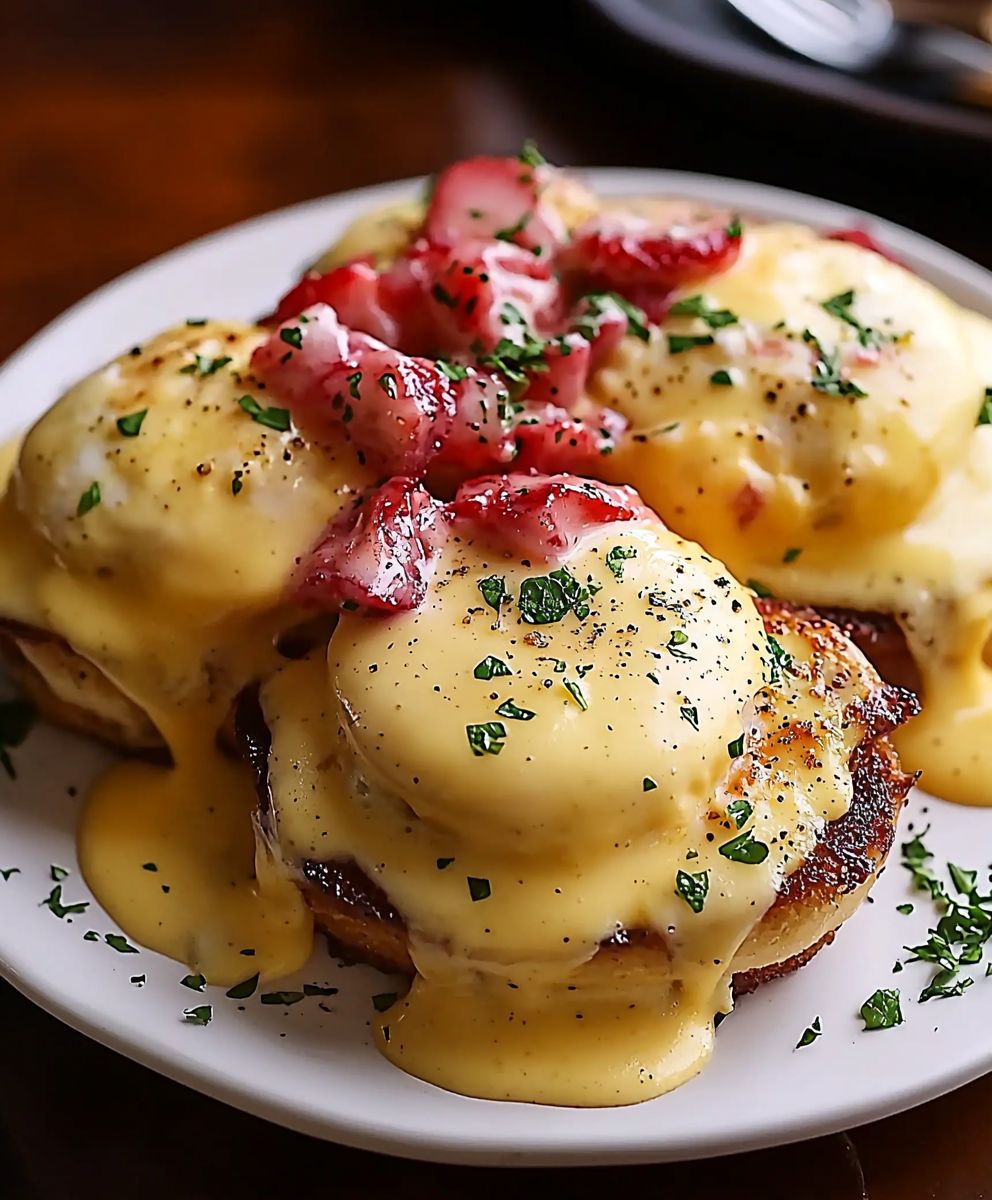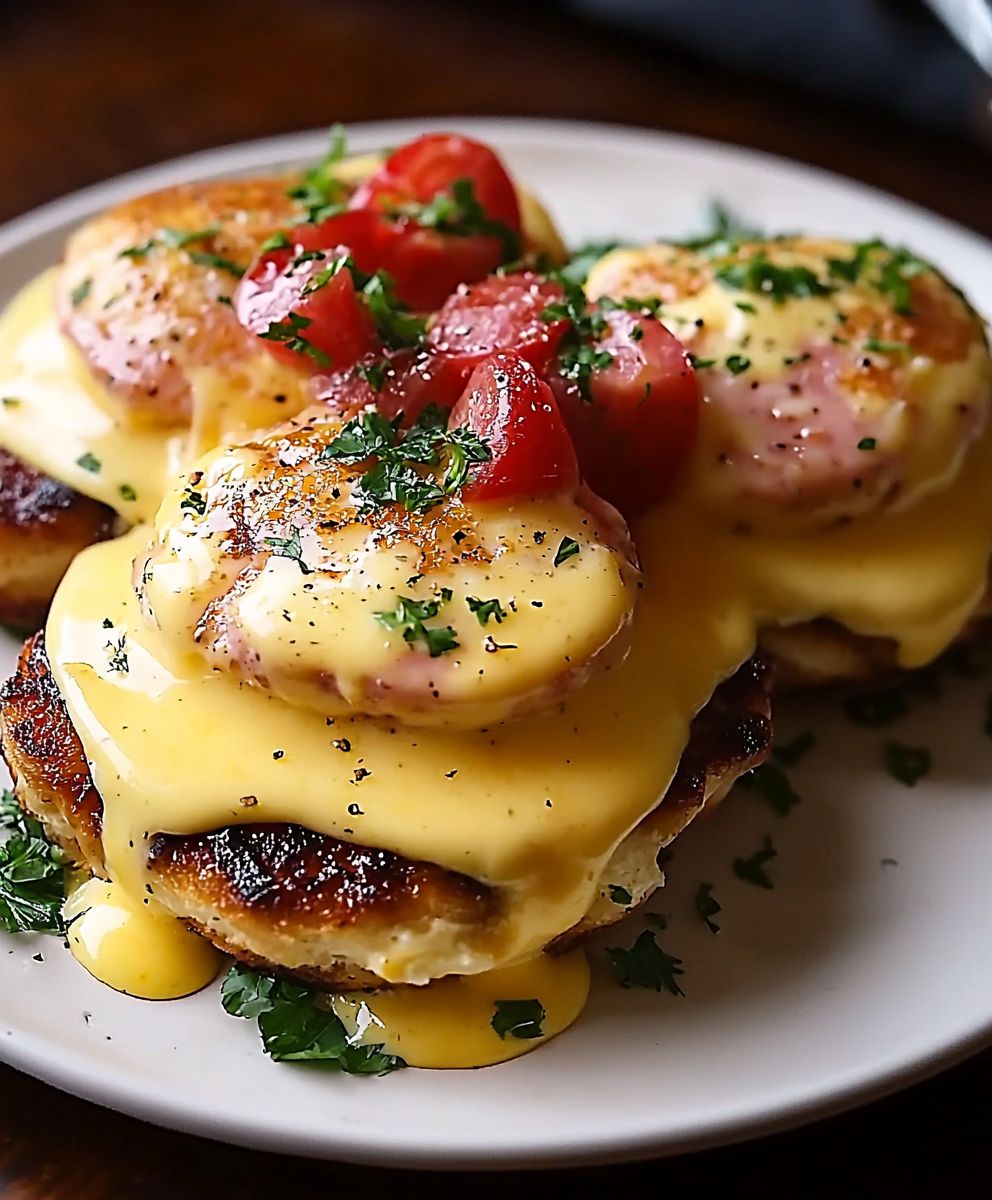Eggs Benedict, a brunch staple that effortlessly marries rich flavors and elegant presentation, is more than just a meal; it’s an experience. Have you ever wondered how this seemingly simple dish became a symbol of weekend indulgence? I certainly have! The story, shrouded in a bit of mystery, points to either Delmonico’s Restaurant in New York City in the 1860s or the Waldorf Hotel a few decades later. Regardless of its exact origin, Eggs Benedict quickly ascended to culinary fame, gracing menus worldwide.
What makes this dish so irresistible? It’s the symphony of textures and tastes, of course! Imagine a perfectly toasted English muffin, topped with savory Canadian bacon (or sometimes ham), a flawlessly poached egg with a runny yolk, and then, the pièce de résistance: a generous blanket of velvety, tangy hollandaise sauce. The creamy richness of the sauce, combined with the salty meat and the delicate egg, creates a flavor explosion that’s both comforting and sophisticated. Beyond the taste, Eggs Benedict offers a certain level of convenience. While it might seem intimidating at first, mastering the components allows you to create a restaurant-quality brunch right in your own kitchen. So, are you ready to unlock the secrets to the perfect Eggs Benedict? Let’s get started!
Ingredients:
- For the Hollandaise Sauce:
- 1 cup (2 sticks) unsalted butter
- 3 large egg yolks
- 2 tablespoons lemon juice, freshly squeezed
- 1 tablespoon water
- 1/4 teaspoon salt, or to taste
- Pinch of cayenne pepper (optional)
- For the Poached Eggs:
- 6 large eggs
- 6 cups water
- 2 tablespoons white vinegar
- Salt and pepper to taste
- For the Canadian Bacon:
- 6 slices Canadian bacon (or ham)
- 1 tablespoon butter or olive oil (optional, for searing)
- For the English Muffins:
- 3 English muffins, split in half
- 2 tablespoons butter, softened
- Garnish (optional):
- Chopped fresh chives or parsley
- Paprika
Preparing the Hollandaise Sauce:
Okay, let’s tackle the Hollandaise first. I know it can seem intimidating, but trust me, with a little patience, you’ll nail it. The key is low and slow heat and constant whisking!
- Melt the Butter: In a small saucepan over medium-low heat, melt the butter completely. Once melted, remove from heat and let it sit for a minute or two. This allows the milk solids to settle to the bottom. We only want the clarified butter (the clear liquid on top) for the smoothest sauce. You can carefully skim off any foam that forms on top.
- Prepare the Double Boiler (or Improvise!): The best way to make Hollandaise is using a double boiler. If you don’t have one, don’t worry! You can easily create one by placing a heatproof bowl (stainless steel or glass) over a saucepan filled with about an inch or two of simmering water. Make sure the bottom of the bowl doesn’t touch the water.
- Whisk the Egg Yolks: In the top of your double boiler (or heatproof bowl), combine the egg yolks, lemon juice, and water. Whisk vigorously until the mixture is pale yellow and slightly thickened. This usually takes about 2-3 minutes.
- Slowly Drizzle in the Butter: This is the most crucial step! Remove the top of the double boiler from the heat for a few seconds. Then, very, very slowly drizzle the melted butter into the egg yolk mixture while whisking constantly and vigorously. I mean slowly think a thin, steady stream. If you add the butter too quickly, the sauce will break (separate).
- Continue Whisking and Heating: Once all the butter is incorporated, return the bowl to the double boiler (or saucepan with simmering water). Continue whisking constantly for another 2-3 minutes, or until the sauce thickens to the consistency of a thin mayonnaise. It should coat the back of a spoon. Be careful not to overheat the sauce, or the eggs will scramble. If it starts to look curdled, immediately remove it from the heat and whisk vigorously.
- Season and Adjust: Remove the Hollandaise sauce from the heat and stir in the salt and cayenne pepper (if using). Taste and adjust the seasoning as needed. You might want to add a little more lemon juice for extra tang.
- Keep Warm (Important!): Hollandaise sauce is best served immediately. To keep it warm while you prepare the rest of the dish, you can place the bowl over a very warm (but not hot) water bath. Whisk occasionally to prevent a skin from forming. Alternatively, you can keep it in a thermos. If the sauce gets too thick, whisk in a teaspoon or two of warm water to thin it out.
Poaching the Eggs:
Next up: perfectly poached eggs. This is another step that can seem tricky, but with a few tips, you’ll be a pro in no time. Fresh eggs are key for the best results!
- Prepare the Water: Fill a large, wide saucepan with about 6 cups of water. Add the vinegar. The vinegar helps the egg whites coagulate faster, resulting in a neater poached egg. Bring the water to a gentle simmer you should see small bubbles forming on the bottom of the pan, but not a rolling boil.
- Crack the Eggs: Crack each egg into a separate small bowl or ramekin. This makes it easier to gently slide the eggs into the simmering water.
- Create a Vortex (Optional but Recommended): Using a spoon, gently swirl the water in the saucepan to create a gentle vortex. This helps the egg white wrap around the yolk as it cooks.
- Gently Slide in the Eggs: One at a time, gently slide the eggs from the bowls into the simmering water. Try to keep them separated so they don’t stick together.
- Cook the Eggs: Cook the eggs for 3-4 minutes for a runny yolk, or longer if you prefer a firmer yolk. The cooking time will depend on the size of the eggs and the temperature of the water.
- Remove the Eggs: Use a slotted spoon to carefully remove the poached eggs from the water. Gently blot them with a paper towel to remove any excess water.
- Trim (Optional): If you want perfectly shaped poached eggs, you can trim off any ragged edges of the egg white with a small knife or kitchen shears.
- Keep Warm (If Necessary): If you’re not serving the eggs immediately, you can keep them warm in a bowl of warm water.
Preparing the Canadian Bacon and English Muffins:
Now for the easy part! This is where we bring everything together.
- Toast the English Muffins: Split the English muffins in half and toast them until golden brown.
- Butter the English Muffins: Spread each toasted English muffin half with softened butter.
- Cook the Canadian Bacon: You can cook the Canadian bacon in a couple of ways. You can simply heat it in a skillet over medium heat until warmed through, about 2-3 minutes per side. Or, for a little extra flavor, you can sear it in a skillet with a tablespoon of butter or olive oil until lightly browned and crispy.
Assembling the Eggs Benedict:
Finally, the moment we’ve all been waiting for! Let’s put it all together and enjoy this delicious breakfast (or brunch!).
- Assemble the Base: Place two toasted and buttered English muffin halves on each plate.
- Add the Canadian Bacon: Top each English muffin half with a slice of cooked Canadian bacon.
- Top with the Poached Eggs: Carefully place a poached egg on top of each slice of Canadian bacon.
- Drizzle with Hollandaise Sauce: Generously drizzle the warm Hollandaise sauce over the poached eggs. Don’t be shy!
- Garnish (Optional): Garnish with chopped fresh chives or parsley and a sprinkle of paprika, if desired.
- Serve Immediately: Serve immediately and enjoy! The key to a great Eggs Benedict is serving it while everything is still warm and the yolk is runny.

Conclusion:
And there you have it! I truly believe this Eggs Benedict recipe is a must-try for anyone who appreciates a truly decadent and satisfying breakfast or brunch. From the perfectly poached eggs with their runny, golden yolks, to the rich and velvety hollandaise sauce, every element of this dish comes together in perfect harmony. It’s a classic for a reason, and once you’ve tasted the homemade version, you’ll understand why it’s worth the effort.
But beyond just the incredible flavor, this recipe is about more than just following instructions; it’s about creating an experience. It’s about the satisfaction of mastering a technique, the joy of sharing a delicious meal with loved ones, and the simple pleasure of indulging in something truly special. Trust me, the look on your guests’ faces when you present them with a plate of perfectly executed Eggs Benedict will be reward enough!
Now, while the classic version is undeniably amazing, don’t be afraid to get creative and put your own spin on things! For a vegetarian option, try swapping out the Canadian bacon for grilled asparagus or sautéed spinach. You could even add some sliced avocado for extra creaminess and healthy fats. If you’re feeling adventurous, consider using smoked salmon instead of Canadian bacon for a luxurious twist.
For serving suggestions, I love pairing Eggs Benedict with a side of crispy roasted potatoes or a fresh fruit salad. A light and bubbly mimosa or a strong cup of coffee are also perfect accompaniments. And if you’re making this for a special occasion, consider adding a sprinkle of fresh herbs like chives or parsley for a touch of elegance.
The key to truly mastering this Eggs Benedict recipe is practice and patience. Don’t be discouraged if your first attempt isn’t perfect. Poaching eggs can be tricky, and hollandaise sauce can be temperamental, but with a little practice, you’ll be whipping up restaurant-quality Eggs Benedict in no time. Remember to keep the heat low and slow when making the hollandaise, and don’t be afraid to add a little extra lemon juice or hot sauce to taste.
I’m so excited for you to try this recipe and experience the magic of homemade Eggs Benedict for yourself! I poured my heart into creating a recipe that is both approachable and rewarding, and I truly believe that anyone can make this dish with a little bit of effort and enthusiasm.
So, what are you waiting for? Gather your ingredients, put on your apron, and get ready to create something truly special. And most importantly, don’t forget to have fun! Cooking should be an enjoyable experience, so relax, experiment, and savor the process.
Once you’ve tried this recipe, I would absolutely love to hear about your experience! Share your photos and stories in the comments below. Let me know what variations you tried, what challenges you faced, and what you loved most about this dish. Your feedback is invaluable, and it helps me to continue creating recipes that you’ll love. I can’t wait to see your Eggs Benedict creations! Happy cooking!
Eggs Benedict: The Ultimate Guide to Making It Perfectly
Classic breakfast dish with poached eggs and Canadian bacon on English muffins, topped with hollandaise sauce.
Ingredients
- 4 English muffins, split
- 8 slices Canadian bacon or ham
- 4 large eggs
- 1 tablespoon white vinegar
- 1/2 cup (1 stick) unsalted butter
- 3 large egg yolks
- 1 tablespoon lemon juice
- Pinch of cayenne pepper (optional)
- Salt and freshly ground black pepper to taste
- Chopped fresh chives, for garnish (optional)
Instructions
- Fill a large saucepan with water and bring to a simmer.
- Add the vinegar.
- Crack each egg into a ramekin.
- Create a gentle whirlpool in the simmering water and gently drop an egg into the center. Repeat with the remaining eggs, being careful not to overcrowd the pan.
- Cook for 3-4 minutes, or until the whites are set and the yolks are still runny.
- Remove the eggs with a slotted spoon and place them on a plate lined with paper towels.
- In a blender or food processor, combine the egg yolks, lemon juice, mustard, and salt.
- Slowly drizzle in the melted butter while blending until the sauce is thick and emulsified.
- Season with pepper to taste.
- Toast the English muffins and spread with butter.
- Top each half with Canadian bacon or ham.
- Place a poached egg on top of the Canadian bacon or ham.
- Spoon hollandaise sauce over the eggs.
- Garnish with paprika or chopped chives, if desired.
- Serve immediately.
“`
Notes
- If the hollandaise sauce is too thick, whisk in a teaspoon of warm water at a time until it reaches the desired consistency.
- If the hollandaise sauce curdles, whisk in a tablespoon of cold water. This can sometimes bring it back together.
- Poaching eggs can be tricky. Adding a tablespoon of vinegar to the water helps the egg whites coagulate faster.
- For perfectly round poached eggs, swirl the water gently before adding the egg.
- English muffins can be toasted in a toaster or under a broiler. Watch them carefully to prevent burning.
- Canadian bacon can be substituted with regular bacon or ham.
“`





Leave a Comment